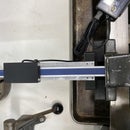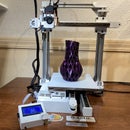Introduction: Upgrade 3D Printer Heated Bed to 110V
I got tired of waiting 10 minutes for my heated bed to get to 70°C? My original bed took 12 minutes to get to 60°C and I never even tried to get to 110°C. It pretty much maxed out at 78 (even inside closed chamber). 12 volts for a 200mm x 300mm bed simply does not seem to do it.
Some users upgrade their bed to 24V and see an improvement but, why not go all the way. I upgraded my bed to 110V and it now heats up to 110°C in 1 minute and 27 seconds.
Before you continue, fair warning. Up to this point your printer probably only has 1 mains (110V) going straight into your power brick. Adding a 110V heated bed now means you'll have 110V coming out of that brick. Furthermore, depending on your printer, your bed may be moving a whole lot, causing all sorts of wear and tear to cables. 110V IS DANGEROUS. Make sure everything is grounded properly and protected from wear and tear. TAKE ALL NECESSARY PRECAUTIONS WHEN DEALING WITH 110V. Oh and if you're in Europe 220V WILL KILL YOU EVEN FASTER!!
Update: one of the commenters brough up grounding. Here is a video that covers that topic: https://www.youtube.com/watch?v=uS65mTojewc
So with that out of the way, let's get going.
Step 1: Materials
There aren't a lot of items you need for this upgrade.
A heater pad. I went with the Keneevo Silicone pad which comes fully wired with both 110V wires and Thermistor
KEENOVO Silicone Heater Mat: $49.50 http://amzn.to/2C0fAqJ
Aluminum Build Plate: $24.99 https://amzn.to/2thliPg
uxcell SSR-25 DA 25A 3-32V DC / 24-380V AC Solid State Relay: $9.95 http://amzn.to/2Cn0Uhm
The Heater Mat I used came fully cabled but if you order something else (non-assembled) you'll also need:
14-16 Gauge wire (lot of Amps going through): $8.95 http://amzn.to/2BtmaoN
Thermistors: $7.38 http://amzn.to/2GhLfCq
You may want to consider putting some sort of protection around your cables like a braided sleeve
braided cable sleeve: $7.99 http://amzn.to/2sy2kpr
Both Build plate and Heater mat are 300x200mm. They are available in other sizes.
Step 2: Installation
The setup and installation is easier than you might expect. On your printer's controller board very little changes. The Thermistor goes where the original thermistor was and the power cables that go to your current heated bed now simply do to the SSR (Solid State Relay). It will take the 12Volt signal from your board and use it to open up the 110V to your new bed.
Be aware that unlike your original heated bed that didn't care about polarity, the SSR does care about Polarity. Make sure you connect the Plus from your board to the Plus on the SSR.
If your bed was not heated before, you'll have to change your software to make it aware of a heated bed. If you are using a RAMPS board this is a matter of changing the Board in configuration.h
// The following define selects which electronics board you have.<br>// Please choose the name from boards.h that matches your setup #ifndef MOTHERBOARD #define MOTHERBOARD BOARD_RAMPS_14_EFB (Extruder, Fan, Bed) #endif
Step 3: The Difference
Like I stated earlier, it makes a world of difference. My old 12V heater could not get the printer past 78°C and it took 12 minutes to get to 60°C
The new 110V bed easily goes past 110°C and gets there in 1 minutes and 27 seconds (As seen in the video attached).
Now, if only I could get my Nozzle heater upgraded as it now takes longer to heat than the bed.
Let me know you experience with 110V heated beds.
If you liked this check out my other instructables or visit my website at https://core3d.tech

Participated in the
Epilog Challenge 9













